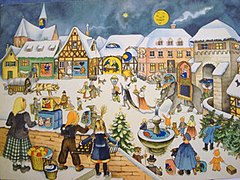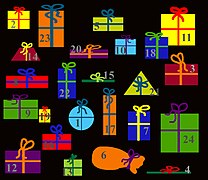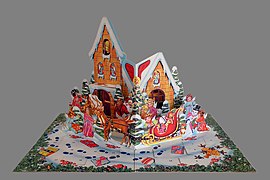Advent calendar

An Advent calendar, from the German word Adventskalender, is used to count the days of Advent in anticipation of Christmas.[1] Since the date of the First Sunday of Advent varies, falling between November 27 and December 3 inclusive, many reusable Advent calendars made of paper or wood begin on December 1. Others start from the First Sunday of Advent.[2][3]
The Advent calendar was first used by German Lutherans in the 19th and 20th centuries, and has since then spread to other Christian denominations.[4][5][6][7]
Design and use
[edit]
Traditional Advent calendars feature the manger scene, Saint Nicholas and winter weather, while others range in theme, from sports to technology.[8] They come in a multitude of forms, from a simple paper calendar with flaps covering each of the days to fabric pockets on a background scene to painted wooden boxes with cubby holes for small items.
Many Advent calendars take the form of a large rectangular card with "Doors", one for each day of December leading up to and including Christmas Eve (December 24) or Christmas Day (December 25). Consecutive doors are opened every day leading up to Christmas, beginning on the start of the Advent season for that year,[2][3] or simply on December 1, as is the case of reusable Advent calendars.
Often the doors are distributed across the calendar in no particular order. The calendar doors open to reveal an image, a poem, a portion of a story (such as the story of the Nativity of Jesus), or a small gift, such as a toy or a chocolate item. Often, each door has a Bible verse and Christian prayer printed on it, which Christians incorporate as part of their daily Advent devotions.[4][9]
There are many variations of Advent calendars; some European villages create advent calendars on buildings or even so-called "living" Advent calendars,[10] where different windows are decorated for each day of Advent.
History
[edit]Germany - Postwar Period to the present day
[edit]Soon after World War II, the longing for an “ideal world” set in, including the Christmas season. By 1945, Advent calendars were once again being produced in all occupation zones. These calendars were primarily based on sweet designs from around 1930. Some publishers, like Erika in Heidenau, reprinted their older works. Today, these calendars can often only be distinguished from the older copies by the poorer quality of the paper and printing after the war. Returning to old originals was ultimately a matter of costs. In addition, some of the designers who had been active before the war continued to work in this field afterwards. Initially, especially tear-off calendars were popular.[11]
The Richard Sellmer publishing house received the license to print advent calendars in December 1945 in Stuttgart, from their American occupiers. The permission to print 50.000 calenders could be covered via paper from the French occupation zone. Richard Sellmer manufactured the stand-up calender The little town Die kleine Stadt designed by Elisabeth Lörcher. He presented it at the Messe Frankfurt and was looking for US-customers. Even the first calender was already designed in English and Swedish. The marketing focus on international sales was obvious from the start. Manuals in English and French were already added to the calenders „Alt-Stuttgart“ since 1948. US soldiers coming home helped in spreading the calenders which lead to Sellmer getting the Major order of 50.000 calenders by an aid organisation for epileptics. [12] After the magazine Newsweek showed a picture of Eisenhower's grandson on an Advent calendar in December 1953, demand rose massively. For 1954 the calendar White House was produced, showing the White House as the central design, surrounded by cowboys, prairie schooners and land yachts. This calendar was also specifically commissioned for the US market, just like the Fairy Tales calendar from the same year. Other producers started following the successful trend as well, and so the calendar Bastelhaus, or Children Workshop respectively, of Ulla Wittkuhn started showing two different designs for the 24th of December: a Christmas tree and Mary with child for the German children, a burning fireplace for the children of the US.[13]
Between 1946 and 1998 more than 230 various Advent calendars were produced by the Sellmer publishing company. The company is now run as a family business in its third generation. Around 2010, it offered approximately 100 different motifs each year. Many of the calendars reflect the varying traditions of the countries for which they are produced. For instance, calendars for Switzerland leave out St. Nicholas, angels in the U.S. have no wings and religious themes are preferred in the United Kingdom.
Other publishers also resumed production in 1946. For a few years, tear-off calendars were widespread, but by around 1950, they had largely been replaced by calendars with fold-out doors. The Ars Sacra publishing house in Munich produced carefully designed calendars full of small details, always focusing on religious themes. Between 1954 and 1976, Gudrun Keussen was primarily responsible for designing the approximately 30 calendars produced by the publishing house. After the company was renamed arsEdition in 1980, the content shifted from religious themes to family-oriented ones.[14] Calendars designed by East Germans, such as Kurt Brandes and Fritz Baumgarten, were among those printed by the Korsch publishing house in Munich, which was founded in 1951. The Korsch publishing house bought many of its designs from other publisher’s and still offers many of the older designs today. Korsch also put marketing strategies into practice just like the imprint of firm names. Korsch is one of the most important and most successful publishing houses of its kind.
Supposedly the most popular figure of the conventional Advent calendars was born of one protestant priest. He adapted the idea of Lang and hid pictures of figures from biblical stories behind 24 little doors. The calendar starting from December 1st with 24 little doors was finally accepted after 1945. Some calendars had more than one little door per date, with the 24 December often among them. The Advent Sundays could also have additional windows, in particular when they were out of the 24 days.[15] The Secret of Christimas, a calendar designed by Paula Jordan, is a so-called Three Kings' calendar and even extended to the Epiphany (6th of January). These calendars were offered by religious publishers in particular and were sold up until the 1960s.[16] Since 1995, Der Andere Advent was published by the ecumenical organization Andere Zeiten and is again an Advent calendar which follows the ecclesiastical year and therefore extends to the 6th of January. Since 2017, Der Andere Advent has an edition for children between the age of 7 and 11 which includes stories, experiments, comics and games.[17]
This Advent calendar gained nationwide popularity in the 1950s, when it was a mass-produced article that was offered at an affordable price. The designs were mainly scenes from romantic, snow-covered little towns. The big window of the 24th of December usually hid a crib scene. There were also hand-painted advent calendars by various artists, one example being the Advent calendars of Leipzig.
The Nordic Julekalender/Julkalender
[edit]In Denmark, Finland, Iceland, Norway and Sweden, there is a tradition of having a Julekalender (Swedish: Julkalender, Finnish: Joulukalenteri, Icelandic: Jóladagatal; the local word for a Yule—or Christmas—calendar) in the form of a television or radio show, starting on December 1 and ending on Christmas Eve (December 24).
The first such show aired on radio in 1957 in the form of the Swedish radio series Barnens adventskalender. The first televised show of the genre aired in 1960 in the form of the Swedish program Titteliture.[18] The first julekalender aired in Denmark was Historier fra hele verden in 1962. The televised julkalender or julekalendar has now extended into the other Nordic countries. In Finland, for example, the show is called Joulukalenteri.
Over the years, there have been several kinds of julekalender. Some are directed at children, some at both children and adults, and some directed at adults alone. There is a Julkalender radio show in Sweden, which airs in the days leading up to Christmas. A classic example of a julekalender enjoyed by children, as well as adults, if purely for nostalgic reasons, is the 1979 Norwegian television show Jul i Skomakergata. Another is the 1990 Icelandic television show Á baðkari til Betlehem.
Image gallery
[edit]- A collection of Advent calendars
-
Advent calendar from Im Lande des Christkinds. The doors contain Christmas poems. Images, from a cut-out sheet, were pasted over them.
-
A 1946 Advent calendar by Marianne Schneegans
-
The 24 windows of the front of Hellbrunn Palace in Salzburg, Austria, used as an Advent calendar during the town's Christmas market
-
A home-made Advent calendar featuring presents
-
An Advent calendar consisting of images that have dates on the inverse side
-
A Norwegian Advent calendar
-
A home-made Advent calendar made from wood in the shape of a Christmas tree
-
Advent Calendar at the City Hall in Stollberg, Saxony
-
Two girls try to open the first door of an Advent calendar at the Kaiser Wilhelm Memorial Church in Berlin.
-
"Living" Advent calendar
-
Advent calendar with presents as flaps, randomly arranged
-
Stand-up Advent calendar by Carlsen Verlag, 1959
-
An Advent calendar featuring Santa Claus riding his sleigh
See also
[edit]References
[edit]- ^ Penney, Sue (1999). Christianity. Heinemann. p. 38. ISBN 9780435304775.
In Advent, Christians use special candles and calendars. Advent candles have marks to show the days until Christmas. The candle is lit each day until it burns down to the next mark. Advent calendars have little doors to open, one for each day. Behind each door is a picture. Candles and calendars like this help to remind people that Christmas is coming closer.
- ^ a b "Online Advent calendar created by the world". Anglican Communion News Service. November 17, 2016. Archived from the original on December 20, 2016. Retrieved December 8, 2016.
] Christians across the world are being invited to celebrate the season of Advent through an interactive, multi-lingual online calendar. The website adventword.org goes live on Advent Sunday (27 November) in nine languages including, for the first time, Arabic. It allows people around the globe to create together an advent calendar with images shared by their mobile phones. Advent, which runs from Sunday 27 November to Christmas Eve, is the season when Christians prepare to celebrate the birth of Jesus. It is traditionally marked with the putting up of an Advent calendar to count down the days. The calendars have daily windows which are opened to reveal images, small chocolates or other gifts.
- ^ a b Mac Donald, Sarah (November 26, 2014). "Primate launches online calendar for Advent". Catholicireland.net. Catholic Ireland. Archived from the original on April 26, 2016. Retrieved December 8, 2016.
The Primate of All Ireland, Archbishop Eamon Martin, on Tuesday launched a specially commissioned 2014 Advent calendar to coincide with the beginning of Advent on Sunday 30 November. The online calendar can be found on the Irish Catholic bishops' website www.catholicbishops.ie. This year's calendar also incorporates a new feature in the form of an audio 'Thought for Today'. In a statement, the Archbishop said "Each day of Advent amounts to a period of time which allows us to journey and reflect on 'the joy of the Gospel." "As Advent is the season of preparation for the coming of our Lord, I encourage the faithful, notwithstanding our hectic schedule over the coming weeks, to make time to pray – alone and with loved ones – and by so doing to draw nearer to Christ," Archbishop Martin encouraged. The first door on the Advent Calendar will open on Sunday next 30 November and each subsequent day after that.
- ^ a b Mills, T.J. (May 10, 2010). The Twelve Blessings of Christmas. Thomas Nelson Inc. p. 54. ISBN 9780529124319.
The Advent calendar was first used by Lutherans in the early 19th century. Early printed Advent calendars had Bible verses behind little cardboard doors.
- ^ Gassmann, Günther; Larson, Duane H.; Oldenburg, Mark W. (April 4, 2001). Historical Dictionary of Lutheranism. Scarecrow Press. p. 87. ISBN 9780810866201.
The periods of Advent and Christmas have been especially dear to Lutherans and have provided ground for the creation and observation of customs: the rich tradition of hymn singing and church music, the Advent wreath as a sign of Christ's victory, the Advent calendar with its "windows," candles symbolizing new light in darkness, the varieties of Advent and Christmas cookies (gingerbread, fruit loaf, and so on) with several spices (originally seven, the holy number), the Christmas tree with glittering decoration and self-made figures and symbols as a reminder of the gold and treasures that the three wise men brought to the Christ Child, the cribs and tableaus within and out front of the churches and houses, and the greeting of Christmas morning by hymns and carols blown by trumpets and trombones from church towers.
- ^ "The Season of Advent: Hope, Love, Joy, and Peace". Reno: Faith Lutheran Church. Retrieved December 9, 2021.
The Advent calendar is used to count the days of Advent in anticipation of Christmas. The Advent calendar was first used by German Lutherans in the 19th and 20th centuries but is now widely used among many Christian denominations .
- ^ McLaughlan, David (September 1, 2012). The Top 40 Traditions of Christmas: The Story Behind the Nativity, Candy Canes, Caroling, and All Things Christmas. Barbour Publishing. ISBN 978-1-62029-108-5.
Like many other Christmas traditions, the Advent calendar was a German invention. It is thought to have originated among Lutheran communities and spread to other churches in the area
- ^ MacBeth, Sybil (November 1, 2014). The Season of the Nativity. Paraclete Press. p. 50. ISBN 9781612616131.
The variety of Advent calendars is endless, and they are available online, in bookstores, and even in some grocery stores. The "old-fashioned," meaning twentieth-century and earlier versions, are made of paper and often include pictures of Santa Claus, the manger, or winter weather. Most calendars have twenty-four little paper doors; behind each is a picture or a Bible passage.
- ^ Black, Vicki K. (January 9, 2004). Welcome to the Church Year: An Introduction to the Seasons of the Episcopal Church. Church Publishing, Inc. p. 17. ISBN 9780819225757.
The Advent Calendar: Another way to mark the progress of Advent is the Advent calendar. Again, many children enjoy this hands-on way of keeping Advent, and families can incorporate prayers and brief Scripture readings or nativity stores into the daily ritual of opening the Advent calendar.
- ^ "Penarth neighbours create 'living' advent calendar". BBC News. December 5, 2016.
- ^ Tina Peschel: Adventskalender. Geschichte und Geschichten aus 100 Jahren. Verlag der Kunst, Husum 2009, ISBN 978-3-86530-114-7, S. 41.
- ^ Spiegel online: einestages vom 30. November 2007: Eisenhowers Advent (Memento vom 11. Juli 2012 im Webarchiv archive.today)
- ^ Tina Peschel: Adventskalender. Geschichte und Geschichten aus 100 Jahren. Verlag der Kunst, Husum 2009, ISBN 978-3-86530-114-7, S. 44.
- ^ Tina Peschel: Adventskalender. Geschichte und Geschichten aus 100 Jahren. Verlag der Kunst, Husum 2009, ISBN 978-3-86530-114-7, S. 47–48.
- ^ Tina Peschel: Adventskalender. Geschichte und Geschichten aus 100 Jahren. Verlag der Kunst, Husum 2009, ISBN 978-3-86530-114-7, S. 26.
- ^ Tina Peschel: Adventskalender. Geschichte und Geschichten aus 100 Jahren. Verlag der Kunst, Husum 2009, ISBN 978-3-86530-114-7, S. 26
- ^ Der Andere Advent – Verein Andere Zeiten e. V.
- ^ "Julkalendern 50 år - Bakgrund". December 10, 2007. Archived from the original on December 10, 2007. Retrieved December 9, 2011.
External links
[edit]- Taylor, Alan (November 30, 2012). "2012 Hubble Space Telescope Advent Calendar". In Focus. The Atlantic.
- Taylor, Alan (December 1, 2018). "2018 Hubble Space Telescope Advent Calendar". In Focus. The Atlantic.













